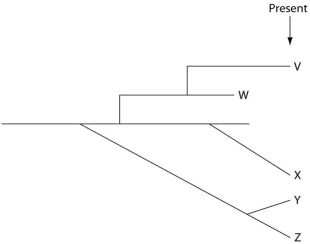The next few questions refer to the following evolutionary tree, whose horizontal axis represents time (present time is on the far right) and whose vertical axis represents morphological change.

-Which conclusion can be drawn from this evolutionary tree?
Definitions:
Neuron's Organelles
The specialized structures within neurons, such as mitochondria, Golgi apparatus, and lysosomes, which perform various crucial functions.
Cell Body/Soma
The part of a neuron that contains the nucleus and connects to dendrites and the axon, playing a crucial role in processing and transmitting neural signals.
Smooth Muscle
A type of muscle found in the walls of hollow organs like the intestines and blood vessels, controlled involuntarily.
Multinucleated
Having more than one nucleus within a single cell, a characteristic seen in certain types of muscle cells and some other organisms.
Q3: One explanation for the evolution of insect
Q11: Sporophylls can be found in which of
Q16: Which of the following supports the argument
Q18: In pools where guppies and pike-cichlids coexist,guppies
Q27: You have found a new prokaryote.What line
Q44: Which protists are in the same eukaryotic
Q52: Why might a laboratory be using dideoxynucleotides?<br>A)to
Q68: Which statement about variation is true?<br>A)All phenotypic
Q70: Assuming that they all belong to the
Q96: Absence of bicoid mRNA from a Drosophila